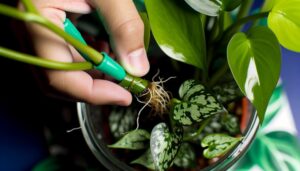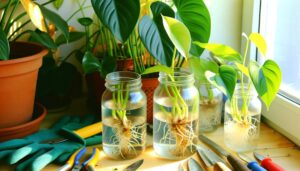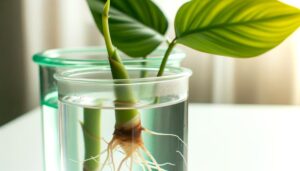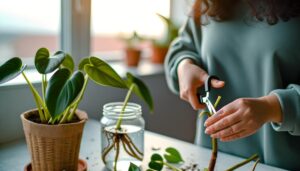Arrowhead Philodendron Propagation: How to Do It Right?
Propagating Arrowhead Philodendron involves several precise steps. Begin with a healthy, disease-free parent plant.
Execute propagation during the spring and early summer when growth is active, maintaining temperatures between 70-85°F (21-29°C). Select a 4-6 inch cutting with at least one healthy node.
Submerge the node in clean water, changing it every 3-5 days to prevent bacterial growth. Guarantee cuttings receive bright, indirect light and maintain high humidity.
Once roots develop, transplant to well-draining soil, making sure minimal root disturbance. Consistent temperature management and appropriate light exposure are critical for successful propagation.
For a detailed step-by-step process, continue on.
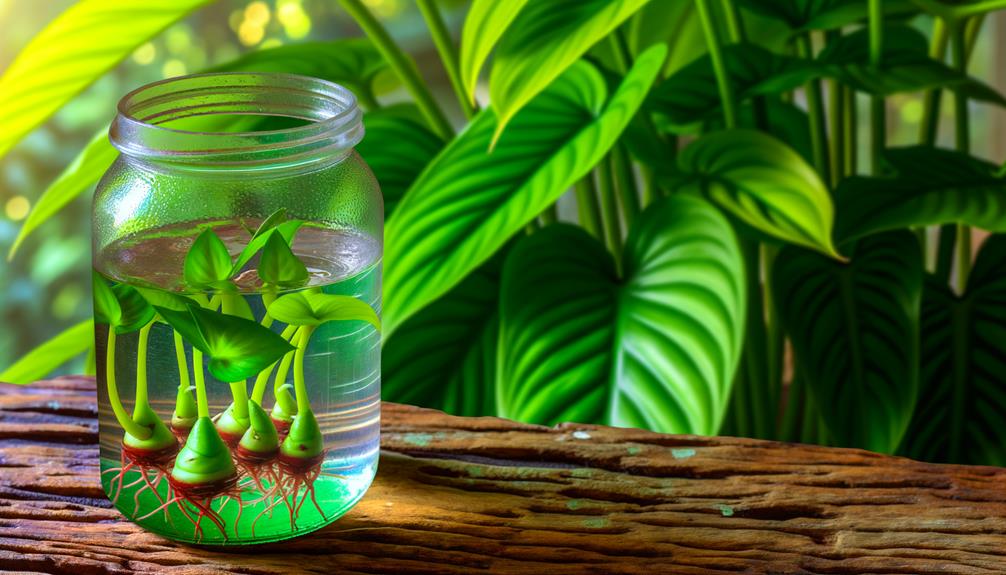
Key Takeaways
- Select mature, disease-free Arrowhead Philodendron stems with at least two nodes for propagation.
- Propagate during spring and early summer, maintaining temperatures between 70-85°F (21-29°C).
- Submerge the cuttings’ nodes in clean water, changing the water every 3-5 days to prevent bacterial growth.
- Place cuttings in bright, indirect sunlight, ensuring light intensity of 10,000-20,000 lux.
- Transplant rooted cuttings into a well-draining potting mix, keeping roots evenly spread and watering thoroughly.
Choosing Healthy Parent Plants
Selecting strong parent plants is crucial for successful Arrowhead Philodendron propagation, as it guarantees the new cuttings inherit peak health and vigor. Choose mature, disease-free specimens exhibiting robust growth, vibrant leaf coloration, and well-developed root systems.
Inspect foliage for signs of chlorosis, pests, or fungal infections, as these conditions can compromise cutting viability. Make sure the parent plant has been appropriately cared for, receiving adequate light, water, and nutrients. Prune away any damaged or weak sections to concentrate the plant’s energy on healthy growth.
Best Time for Propagation
Propagation of Arrowhead Philodendron is most successful during periods of active growth, typically in spring and early summer, when best seasonal conditions prevail.
It is important to take into account the plant’s growth cycle phases, particularly when new shoots and roots are developing.
Maintaining an ideal temperature range of 70-85°F (21-29°C) helps achieve the best rooting and overall plant health.
Optimal Seasonal Conditions
Understanding the best seasonal conditions for propagating Arrowhead Philodendrons is crucial for ensuring successful root development and plant growth. Propagation occurs during the spring and early summer months when environmental factors favor root initiation and shoot development. Warm temperatures, increased humidity, and longer daylight hours provide the ideal microclimate for cuttings to establish roots. Consistent temperatures between 65-75°F (18-24°C) and high humidity levels (above 60%) are recommended. Below is a table summarizing the most favorable seasonal conditions:
| Factor | Optimal Range |
|---|---|
| Temperature | 65-75°F (18-24°C) |
| Humidity | Above 60% |
| Daylight Hours | 12-14 hours |
| Season | Spring to Early Summer |
| Watering Frequency | Moderate to High |
Adhering to these parameters will greatly enhance propagation success.
Growth Cycle Phases
Recognizing the distinct phases of the Arrowhead Philodendron‘s growth cycle can greatly inform the timing and method of propagation efforts. Typically, the best period for propagation coincides with the plant’s active growth phase, which occurs during late spring to early summer.
During this time, the plant exhibits vigorous vegetative growth, enhancing the likelihood of successful root development in cuttings. The production of new leaves and stems indicates high metabolic activity, facilitating faster rooting. It is advisable to select healthy, mature stems with at least two nodes for cuttings.
Ensuring the parent plant is well-hydrated before propagation can further improve success rates. Employing this knowledge allows for strategic propagation, maximizing plant health and growth potential.
Ideal Temperature Range
Maintaining a temperature range between 70°F and 85°F (21°C to 29°C) is essential for maximizing the propagation success of Arrowhead Philodendron. This specific temperature range promotes cellular activities, including root initiation and leaf development, which are critical during the propagation phase.
Lower temperatures can slow metabolic processes, leading to diminished growth rates and increased susceptibility to pathogens. Conversely, excessively high temperatures may induce thermal stress, potentially causing tissue damage.
To ensure consistency, use a digital thermostat to monitor and maintain the desired temperature range in the propagation environment. Additionally, consider propagating during late spring to early summer when natural conditions align closely with these ideal temperatures, thereby reducing the need for artificial climate control. This approach enhances the likelihood of successful propagation outcomes.
Necessary Tools and Supplies
For successful propagation of Arrowhead Philodendron, it is crucial to assemble the appropriate tools and materials. Essential tools include sterilized pruning shears, rooting hormone, and propagation trays.
The required growing medium should be a well-draining mix, such as a combination of peat moss and perlite, to achieve excellent root development.
Essential Propagation Tools
Properly spreading an Arrowhead Philodendron requires a well-chosen selection of tools and supplies to ensure successful growth and development. Key tools include a sterilized pair of pruning shears or scissors for precise cutting of stem segments, reducing the risk of infection.
Rooting hormone powder is crucial to improve root initiation and accelerate growth. Transparent spreading containers, such as glass jars or plastic pots, allow for monitoring root development. A clean, sharp knife is also essential for making clean cuts.
Additionally, a spray bottle guarantees controlled moisture levels, and a humidity dome aids in maintaining ideal humidity. Accurate labeling tools and a sterile working surface further contribute to a controlled and efficient spreading environment.
Required Growing Medium
Selecting the appropriate growing medium is crucial for the successful propagation of Arrowhead Philodendrons, as it directly impacts root development and overall plant health. A well-aerated, well-draining medium is essential.
A recommended blend consists of equal parts peat moss, perlite, and coarse sand. Peat moss retains moisture while perlite and coarse sand guarantee adequate drainage and aeration, preventing root rot.
Sterilize all components by baking at 180°F for 30 minutes to eradicate pathogens. Additionally, a balanced, water-soluble fertilizer with an N-P-K ratio of 20-20-20 can be incorporated at half strength to provide essential nutrients.
Maintain the medium consistently moist but not waterlogged, optimizing conditions for root initiation and growth.
Taking Stem Cuttings
Initiating the propagation of an Arrowhead Philodendron through stem cuttings requires selecting healthy, vigorous stems with at least one node and a few attached leaves. The chosen stem should exhibit no signs of disease or pest infestation to ensure best growth and development.
Using sterilized pruning shears, make a clean cut just below a node, ensuring the cutting is approximately 4-6 inches in length. Nodes are vital as they contain the meristematic tissue necessary for root formation.
Once cut, immediately place the stem cutting in a clean container to prevent desiccation. It is crucial to maintain proper hygiene throughout the process to minimize the risk of pathogen transmission, thereby promoting a successful propagation outcome.
Preparing Cutting for Rooting
Ensuring the stem cutting is adequately prepared for rooting involves treating the cut end with a rooting hormone to stimulate root development and enhance the likelihood of successful propagation.
First, select a cutting with at least one node and remove the lower leaves to prevent decay. Dip the cut end into a powdered or gel-based rooting hormone, ensuring full coverage. This application accelerates auxin accumulation, promoting cellular differentiation and root formation.
Make a precise, clean cut just below the node using sterilized pruning shears to minimize tissue damage and reduce infection risk. Allow the cutting to air dry for a few hours to form a callus, which will further prevent rot when planted.
This methodical preparation optimizes the cutting for subsequent rooting processes.
Rooting in Water
Initiating the rooting process for Arrowhead Philodendron cuttings involves selecting healthy, disease-free cuttings with at least one node.
The cuttings should be placed in a container filled with clean, room-temperature water, ensuring the node is submerged.
Regular water changes, ideally every 3-5 days, are essential to prevent bacterial growth and promote best root development.
Selecting Healthy Cuttings
To propagate arrowhead philodendron successfully, select cuttings that are robust, disease-free, and contain at least one node with a healthy leaf. Begin by identifying a vigorous, mature stem free from any signs of pest infestation or fungal infections.
Using a sterilized, sharp blade, cut a segment that includes at least one node, which is essential for root development. Guarantee the chosen stem segment measures approximately 4-6 inches in length.
Remove any lower leaves to prevent submersion and subsequent decay in water. The node should be submerged in water, while the leaf remains above the surface. This method ensures best nutrient absorption and reduces the risk of rot, facilitating effective root initiation and growth.
Water Change Routine
Regularly replacing the water in which arrowhead philodendron cuttings are rooted is important for preventing bacterial growth and ensuring best oxygenation. To maintain prime conditions, it is recommended to change the water every 3-5 days.
Begin by gently removing the cuttings and setting them aside in a temporary container. Thoroughly rinse the propagation vessel to eliminate any biofilm or debris. Fill the vessel with fresh, room-temperature water, ensuring it is free from chlorine and other contaminants—using distilled or filtered water is ideal.
Reintroduce the cuttings into the clean water, ensuring that nodes remain submerged. Regular monitoring for any discoloration or odor is essential, as these are indicators of potential microbial contamination. This routine supports robust root development.
Rooting in Soil
Rooting Arrowhead Philodendron cuttings in soil demands meticulous attention to soil makeup, moisture levels, and environmental conditions to secure successful propagation. Utilize a well-draining potting mix, ideally a blend of peat, perlite, and vermiculite, to maintain aeration and moisture balance. Ensure the soil remains consistently moist but avoid waterlogging, which can lead to root rot. Maintain ambient temperatures between 70-75°F (21-24°C) and high humidity levels to foster peak root growth. Insert cuttings into the soil at a 45-degree angle to enhance root contact and stability.
| Factor | Recommendation | Importance Level |
|---|---|---|
| Soil Composition | Peat, perlite, and vermiculite mix | High |
| Moisture Levels | Consistently moist, not waterlogged | Critical |
| Temperature | 70-75°F (21-24°C) | High |
| Humidity | High humidity levels | Essential |
Providing Proper Light
Proper lighting is crucial for the best growth and propagation of Arrowhead Philodendron cuttings. Ideal light conditions involve bright, indirect sunlight. Direct sunlight can scorch the leaves, hindering photosynthesis and overall plant health.
Ideally, place cuttings near an east or north-facing window where they receive ample natural light without direct exposure. Supplemental artificial lighting, such as fluorescent or LED grow lights, can be utilized if natural light is insufficient. Maintain a light intensity of approximately 10,000 to 20,000 lux.
Rotate the cuttings periodically to ensure uniform light distribution. Avoid placing them in low-light areas, as this can lead to etiolation, characterized by weak and elongated stems. Proper light management is essential for strong rooting and subsequent growth.
Watering New Cuttings
Ensuring perfect hydration is crucial for the successful establishment of Arrowhead Philodendron cuttings. After cutting, immerse the basal ends in distilled or dechlorinated water to alleviate chlorosis and promote root initiation.
Maintain a water level sufficient to submerge at least one node, ensuring continuous contact with the liquid medium. Change the water every 3-5 days to prevent microbial growth and oxygen depletion.
Utilize transparent containers to monitor root development and detect early signs of pathogens. Ambient humidity around 60-70% is beneficial, achieved through misting or humidity trays.
Avoid waterlogging, as it may induce anaerobic conditions detrimental to root health. Adequate hydration, combined with periodic water renewal, fosters perfect conditions for root morphogenesis.
Transplanting Rooted Cuttings
Successfully transplanting rooted Arrowhead Philodendron cuttings requires careful preparation and attention to detail to achieve best potential growth and development. Begin by selecting a well-draining potting mix, such as a blend of peat moss, perlite, and vermiculite.
Guarantee that the new container has adequate drainage holes to prevent water logging. Gently remove the rooted cutting from its initial medium, being cautious not to damage the delicate root system. Place the cutting into the prepared pot, ensuring the roots are spread evenly.
Fill around the roots with potting mix, firming it gently to eliminate air pockets. Water thoroughly to settle the soil, providing initial hydration. Position the transplanted cutting in indirect light, maintaining consistent humidity and temperature for best acclimatization.
Troubleshooting Common Issues
Frequently, Arrowhead Philodendron propagation encounters issues such as root rot, pest infestations, and inadequate acclimatization, necessitating vigilant monitoring and prompt intervention.
Root rot, often caused by overwatering or poor drainage, can be mitigated by ensuring soil aeration and moderating watering frequency. Inspect roots regularly, removing any that appear mushy or discolored.
Pest infestations, including spider mites and aphids, require immediate treatment using insecticidal soap or neem oil. Regularly examine foliage for signs of pests.
Inadequate acclimatization manifests as wilting or yellowing leaves; gradually adjust cuttings to new environments by controlling humidity, light, and temperature conditions.
Employing these measures enhances successful propagation, ensuring robust development and growth of Arrowhead Philodendron specimens.
Conclusion
The propagation of arrowhead philodendron is akin to nurturing a budding scientist in a meticulously equipped laboratory. By selecting healthy parent plants, timing propagation precisely, utilizing appropriate tools, and adhering to detailed methodology for stem cuttings, preparation, and care, successful propagation can be achieved.
Ensuring proper light, hydration, and eventual transplantation of rooted cuttings completes the process. Addressing and troubleshooting common issues is essential for robust plant development, ensuring the flourishing of new growth from well-prepared cuttings.

